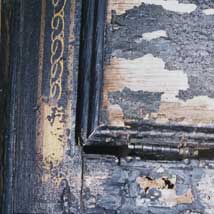
Gilding and Replacement Carving, Conservation and Restoration

Preserving an original surface

A severely damaged surface
About Conservation
An old gilded surface which needs to be preserved in its current state requires a different approach from that used in restoration. A knowledge of how it was constructed originally, and with what processes and materials, is essential so that the treatment is sympathetic, sparing and effective, and does not alter the time-worn integrity of the gilded surface and its substrate.
Examples
Revealing original Georgian gilding
Retouching a gesso table
Restoration
Through time, gilded objects such as frames of mirrors or pictures, or furniture, become damaged, and then restoration is necessary. Depending on what it is made from, the base for re-gilding is constructed in the same way as it was originally, with the same strengths of composition, glues and colourings, prior to the application of the gold or silver leaf. The carat of gold is always matched with the original as the surface requires and the restoration is blended seamlessly with the look of the original surface finish.
Examples
Restoration of lacquered clock case
Restoration of gilded clock cover




